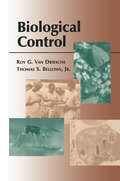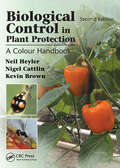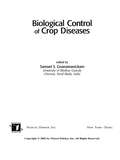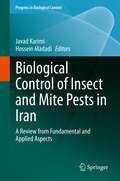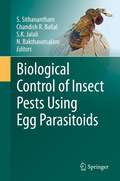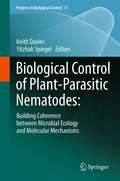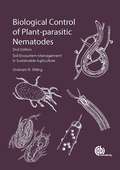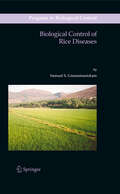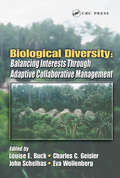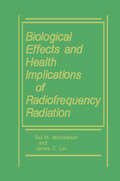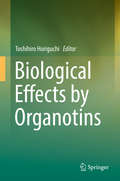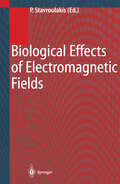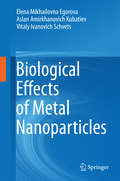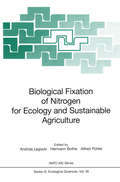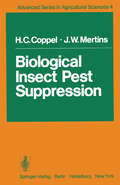- Table View
- List View
Biological Control: An Introduction To Biological Control (pdf) (Thomas Say Monographs)
by Roy Van Driesche Thomas S. Bellows Jr.Biological Control in Plant Protection: A Colour Handbook, Second Edition
by Neil Helyer Nigel D. Cattlin Kevin C. BrownThere has been a large increase in the commercial use of integrated crop/pest management methods for pest and disease control on a wide range of crops throughout the world since the first edition of this book. The completely revised second edition of the bestselling Biological Control in Plant Protection: A Color Handbook continues the objective of
Biological Control of Crop Diseases
by Samuel S. GnanamanickamWith contributions from more than 30 internationally renowned experts, this book combines coverage of theory with coverage of global practices. Highlighting the day-to-day challenges of organic crop management for cost-effective real-world application, the book explores the biological control of diseases in 12 major crops. It focuses on the use of host plant resistance through transgenics and induced systemic resistance as a part of biological control. Topics covered include the role of biocontrol agents for signalling resistance, effective ecofriendly alternative to combat bacterial, fungal, and viral infestation, and transgenic crops in disease management.
Biological Control of Crop Diseases
by Samuel S. GnanamanickamWith contributions from more than 30 internationally renowned experts, this book combines coverage of theory with coverage of global practices. Highlighting the day-to-day challenges of organic crop management for cost-effective real-world application, the book explores the biological control of diseases in 12 major crops. It focuses on the use of host plant resistance through transgenics and induced systemic resistance as a part of biological control. Topics covered include the role of biocontrol agents for signalling resistance, effective ecofriendly alternative to combat bacterial, fungal, and viral infestation, and transgenic crops in disease management.
Biological Control of Insect and Mite Pests in Iran: A Review from Fundamental and Applied Aspects (Progress in Biological Control #18)
by Javad Karimi Hossein MadadiThe book provides a reference to biological control of arthropod pests in agriculture and of public health importance in Iran. A quick glance over the literature shows a long history of biocontrol attempts in the country. Some historically important events highlighting the interest of Iranian academic, research and extension fields to the natural enemies and their applied aspects are provided. Iran, with an exception of the former USSR, was a pioneer in both basic and applied biocontrol in West Asia. The book consists of four parts: three parts for predators, parasitoids and pathogens, and last part for other approaches and analyses of the current state of biological control in Iran. The book provides the most up-to-date information on pest control and related topics of entomology in Iran. The chapters are written by scholars from major Universities and research centers in Iran.
Biological Control of Insect Pests Using Egg Parasitoids
by S. Sithanantham, Chandish R. Ballal, S. K. Jalali and N. BakthavatsalamThe theme of the book is highly relevant to the current emphasis on environment conservation, with focus on native biodiversity conservation in agro-ecosystems. The current impetus being given to organic farming and export oriented agri-hortculture in the country calls for access to relevant scientific knowledge base among the stakeholders. Research on biological pest control is more than a century old in India. Egg parasitoids, which are mainly tiny wasps, led by the family Trichogrammatidae, are the most widely utilized natural enemies for biological control globally. Over thirty countries are using these bioagents to protect over 10 million hectares of agricultural and forestry crops from many important insect pests. The book comprises 18 chapters, which are arranged in continuum, commencing with basic aspects of knowledge and ending in their utilization targets. The chapters cover broadly four areas: bio-diversity and natural occurrence of egg parasitoids, behaviour and adaptation of egg parasitoids, mass production and safe use of egg parasitoids and utilisation of egg parasitoids in different crop ecosystems. Some of the chapters cater to the needs of discipline-wise update on the current R&D scenario-like insect taxonomy, biotechnology, mass-production and quality control of the target organisms - egg-parasitoids, which are useful for laboratory scientists/researchers. There are also chapters devoted to knowledge status and scope for utilization of egg parasitoids in different target crops, which cater to requirements of field entomologists and extensionists for use in their tasks of guiding farmers/local guides. The book is different in approach, method, structure and content and ensures holistic coverage of the topic. The chapters are written by active and experienced workers in different crops and aspects and co-edited by four very experienced experts who have over three decades R&D experience in the subject. All the authors have uniformly focussed on comprehensive literature study and critical identification of knowledge gaps for future R&D, thus the book is novel in outlook, up-to-date in content and comprehensive in coverage of themes. This book will be useful for supplementary reading for MSc Agriculture and PhD Agriculture students, besides MSc/PhD research students in Zoology/Environmental Biology, who are specialising in Entomology. It would also serve as a very useful reference book for researchers worldwide, though focus is also there on Indian work. It addresses the special information needs of students and faculty, besides practitioners and extensionists in the Australasia and Africa regions and thus not limited to the R&D knowledge generated in developed countries.
Biological Control of Plant-Parasitic Nematodes: Building Coherence between Microbial Ecology and Molecular Mechanisms (Progress in Biological Control #11)
by Keith G. Davies and Yitzhak SpiegelThe offered volume intends to review the biological control theme of phytonematodes from several prospects: ecological; applicative as well as commercial state of the art; understanding the mode-of-action of various biocontrol systems; interaction between the plant host, nematodes’ surface and microorganism’s; candidates for biocontrol; extrapolation of the wide knowledge existed in another systems for understanding biocontrol processes: C. elegans as a model and lessons from other natural systems; and exploiting advanced genomic tools to promote understanding biocontrol processes and thereafter improve specific biological control agents.
Biological Control of Plant-parasitic Nematodes: Soil Ecosystem Management in Sustainable Agriculture
by Graham StirlingPlant-parasitic nematodes are one of multiple causes of soil-related sub-optimal crop performance. This book integrates soil health and sustainable agriculture with nematode ecology and suppressive services provided by the soil food web to provide holistic solutions. Biological control is an important component of all nematode management programmes, and with a particular focus on integrated soil biology management, this book describes tools available to farmers to enhance the activity of natural enemies, and utilize soil biological processes to reduce losses from nematodes.
Biological Control of Rice Diseases (Progress in Biological Control #8)
by Samuel S. GnanamanickamThere is suf?cient need to document all the available data on biological control of rice diseases in a small volume. Part of this need rests on the global importance of rice to human life. In the ?rst chapter, I have tried to show that rice is indeed life for most people in Asia and shortages in production and availability can lead to a food crisis. While rice is cultivated in most continents, biological disease management attains special relevance to rice farmers of Africa, Asia, and also perhaps, Latin America. These farmers are resource-poor and might not be able to afford the cost of expensive chemical treatments to control devastating rice pathogens such as Magnaporthe oryzae (blast), Xanthomonas oryzae pv. oryzae (bacterial leaf blight), Rhizoctonia solani (sheath blight) and the virus, rice tungro disease. In an earlier volume that I developed under the title, Biological Control of Crop Diseases (Dekker/CRC Publishers, 2002), I included transgenic crops generated for the management of plant pathogens as biological control under the umbrella of a broad de?nition. Dr Jim Cook who wrote the Foreword for the volume lauded the inclusion of transgenic crops and induced systemic resistance (ISR) as a positive trend toward acceptance of host plant resistance as part of biocontrol. I continue to subscribe to this view.
Biological Control Programmes in Canada 2001-2012
by Tara D Gariepy Sue M Boyetchko Kevin D Floate Barry Lyons Jean J Turgeon Jacques Brodeur Rob McGregor Hector Cárcamo Tim Haye Joan Cossentine Paul Abram Neil Holliday Howard Thistlewood John Gavloski Dave Langor Charles Vincent Christian Hébert Gilles Boiteau Naomi Cappuccino Guy Boivin Bruce Broadbent Laura Timms Martin Erlandson Alan Watson Rob Bourchier Rosemarie De Clerck-Floate Alec McClay Gary PengCanada is a world leader in biological control research. Reporting the status of biocontrol agents released in Canada over the last decade, this book presents case studies by target pest that evaluate the impact of biocontrol and recommend future priorities. In addition to a new chapter on future targets and an appendix listing established agents, this edition contains information of interest to a global audience, and chapters that address effects of invasive species and climate change.
Biological Control Programmes in Canada, 2013-2023
by Charles Vincent Ian Scott Patrice Bouchard Tim Haye Rosemarie De Clerck-Floate Naomi Cappuccino Jacques Brodeur John Gavloski Martin Erlandson Frédéric Jean Kathleen Ryan Eric Lucas Jon Sweeney Alec McClay Marianne Elliott Christopher Saunders Tim J Dumonceaux Maya Evenden Christine Noronha Anne-Marie Fortier Gene Jones Dr Gary Gibson Marc Kenis Natalia Kirichenko John C. Vederas Paul K. Abram Susanna Acheampong Patrice Audy Jacob V. Basso Tracey Baute Roger L. Becker Koïchi Beltrando Andrew M.R. Bennett Jonathan Bernardo-Santos Suzanne E. Blatt Michael K. Bomford Sébastien Boquel Robert S. Bourchier Susan M. Boyetchko Andrea M. Brauner Luc Brodeur Rosemarije Buitenhuis Erin Bullas-Appleton Juli Carrillo Allan L. Carroll Haley Catton Daniel Cormier Ghislaine Cortat Jenny S. Cory Joan E. Cossentine Isabelle Couture Massimo Cristofaro Carly A. Demers Pauline S. Deschodt Peggy L. Dixon Josée Doyon Shelby V. Dufton François Dumont David J. Ensing Nadir Erbilgin Diana Catalina Fernandez José L. Fernández-Triana Jeffrey G. Fidgen Annabelle Firlej Kevin D. Floate François Fournier Marc Fournier Michelle T. Franklin Annie-Ève Gagnon Bruno Gallant Tara D. Gariepy John F. Gaskin Justin M. Gaudon Eric M. Gerbrandt Pierre Girod Angela E. Gradish Sara Grauby Vojislava Grbic Patrick Häfliger Rebecca H. Hallett Vincent A. Hervet Hariet L. Hinz Tracy K. Hueppelsheuser Corey Hughes Lauréline F. Humair Jeremy Hummel Sarah Jandricic Alida F. Janmaat Rob C. Johns Ian M. Jones Amanda M. Jorgensen Gary J. Judd J. Todd Kabaluk Elizabeth J. Katovich Christopher W. Kirby Jennifer G. Klutsch Didier Labarre Roselyne M. Labbé Geneviève Labrie Simon Lachance Jacques Lasnier Jean-Philippe Légaré Jason Lemay Serena K. Leo Jeffrey L. Littlefield Felix Longpré Marlee-Ann E. Lyle Jesse L. MacDonald Maggie MacDonald Chris J. MacQuarrie Francesca Marini Valerie Marshall Véronique Martel Cara McCreary Michael J. McTavish Jacob H. Miall Val Miller Chandra E. Moffat Debra L. Moreau Boyd A. Mori Benoit Morin Tyler D. Nelson Owen O. Olfert Jennifer K. Otani Emily Owens Jean-Philippe Parent Carolyn K. Parsons Erica E. Pate Cyrane Pouët Caroline Provost Justin M. Renkema Tamara Richardson Sabrina Rondeau Albert Remus Rosana Lucas E. Roscoe Krista Ryall Mark Schwarzländer Cynthia Scott-Dupree Simon Francis Shamoun Jade Sherwood Dylan M. Sjolie Timothy Skuse Jocelyn Smith Sandy M. Smith Juliana J. Soroka Michael Stastny Sonja Stutz Ashley Summerfield Ivo Toševski Amanda P. Tracey Susan C. Turner Willem G. Herk Kate Van Rooyen Udari M. Wanigasekara Philip S.R. Weyl Hester E. Williams Jonathon L. Williams Warren H. WongBiological control is an important component of integrated and ecological pest management programmes. Its importance continues to increase as plant protection is challenged with climate change, invasive species, pesticide resistance, de-registration of pesticide active ingredients, and increasing consumer demands for sustainably produced food and fibre. Biological control is highly compatible with organic cropping systems and evolving pest management frameworks, including biovigilance. Canada continues to be a world leader in biological control research, development of biological control policy, and implementation of biological control programmes. This is the sixth volume of a series of books reporting on the status of biological control research and on biological control programmes employed in Canada. This volume features 58 case study chapters that describe the research and progress in implementation of biological control for pests including insects, mites, weeds, and plant pathogens. Topics important to biological control, including policy, emerging technologies, biological control in urban landscapes and future targets for biological control are reviewed. Although the volume focusses on the Canadian biological control experience, the chapters will be of interest to a global audience of researchers and students of biological control, risk assessment, ecology, and pest management. This book Offers a detailed analysis of the state-of-the-art of biological control in Canada. Explains how biological control research is responding to challenges including climate change and invasive alien species. Gives insights in effective risk assessment and pest management. It is a valuable resource for students and researchers of pest management and biological control, and for practitioners and policy-makers needing analysis of the practical implications of using this approach.
Biological Controls for Preventing Food Deterioration: Strategies for Pre- and Postharvest Management
by Neeta SharmaVarious biotic factors cause diseases in crops, which result in food losses. Historically pesticide development has been instructive to us in terms of the benefits derived as well as the hazards that accompany their indiscriminate use. The application of fertilizers and pesticides to crops has become a norm in agricultural production, but this has led to resurgence in pests as they have developed resistance to such chemicals. Biological control of plant pests and pathogens is part of the solution to this problem. This is an area that continues to inspire research and development. It is also the foundation on which sustainable, non-polluting pest control for tomorrow’s farms must be built. Biological Controls for Preventing FoodDeterioration provides readers with options of non-chemical, eco-friendly, environmentally safe natural alternatives to prevent food from spoilage at pre- and postharvest stages. It covers the principles behind these techniques and their implementation. By integrating theory and practice, this book discusses the potential and associated problems in the development of non-chemical alternatives to protect food and addresses the common hurdles that need to be overcome to enable commercialization and registration of natural products for combating diseases. Focussing on plant foods, this timely book is unique in scope as it offers an international perspective on food deterioration caused by bacterial, fungal, viral, and mycotoxin contamination. It brings together highly respected scientists from differingyet complementary disciplines in one unified work that is important reading for food safety professionals, researchers and students.
Biological Controls for Preventing Food Deterioration: Strategies for Pre- and Postharvest Management
by Neeta SharmaVarious biotic factors cause diseases in crops, which result in food losses. Historically pesticide development has been instructive to us in terms of the benefits derived as well as the hazards that accompany their indiscriminate use. The application of fertilizers and pesticides to crops has become a norm in agricultural production, but this has led to resurgence in pests as they have developed resistance to such chemicals. Biological control of plant pests and pathogens is part of the solution to this problem. This is an area that continues to inspire research and development. It is also the foundation on which sustainable, non-polluting pest control for tomorrow’s farms must be built. Biological Controls for Preventing FoodDeterioration provides readers with options of non-chemical, eco-friendly, environmentally safe natural alternatives to prevent food from spoilage at pre- and postharvest stages. It covers the principles behind these techniques and their implementation. By integrating theory and practice, this book discusses the potential and associated problems in the development of non-chemical alternatives to protect food and addresses the common hurdles that need to be overcome to enable commercialization and registration of natural products for combating diseases. Focussing on plant foods, this timely book is unique in scope as it offers an international perspective on food deterioration caused by bacterial, fungal, viral, and mycotoxin contamination. It brings together highly respected scientists from differingyet complementary disciplines in one unified work that is important reading for food safety professionals, researchers and students.
Biological Diversity: Balancing Interests Through Adaptive Collaborative Management
by Louise E. Buck Charles C. Geisler John Schelhas Eva WollenbergWe live in a world of wide pendulum swings regarding management policies for protected areas, particularly as they affect the involvement of local people in management. Such swings can be polarizing and halt on-the-ground progress. There is a need to find ways to protect biodiversity while creating common ground and building management capacity thr
Biological Diversity: Balancing Interests Through Adaptive Collaborative Management
by Louise E. Buck Charles C. Geisler John Schelhas Eva WollenbergWe live in a world of wide pendulum swings regarding management policies for protected areas, particularly as they affect the involvement of local people in management. Such swings can be polarizing and halt on-the-ground progress. There is a need to find ways to protect biodiversity while creating common ground and building management capacity thr
Biological Effects and Health Implications of Radiofrequency Radiation
by James C. Lin Sol M. MichaelsonThe study of electromagnetic bioeffects is multidisciplinary; it draws heavily from the disciplines of physics, engineering, mathematics, biol ogy, chemistry, medicine, and environmental health. This book is about these disciplines and how they mutually integrate in the study of electromagnetic pathophysiology. Over aperiod of years, the authors have become increasingly aware of the difficulty in locating information concerning interaction of electro magnetic energy and biological tissues. There are numerous reports and publications, but no single comprehensive source in the American literature where such information is readily accessible. Regrettably, much of the importantinformation is contained in government documents and reports, some of which are inaccessible, or spread through many diverse journals, making retrieval and analysis of the material difficult. Although this book is primarily clinically oriented, it also focuses on those biophysical, biochemical, and fundamental molecular studies and findings that provide the basis for understanding the presence or absence of pathophysiological manifestations of exposure to radiofrequency, including microwave, energies. Detailed discussion and analysis of the relevant comprehensive physics, engineering, and biophysics are con tained in Chapters 2-5. Because the treatment is multidisciplinary, wherever possible analy sis is begun with basic background information that may appear elementary to some readers but is essential to understanding for those from a different discipline. Most confusion and controversies that exist in the field today arise from individuals of one discipline not appreciating basic facts or theories from another.
Biological Effects by Organotins
by Toshihiro HoriguchiThis book provides an overview of the induction mechanism of imposex caused by organotin compounds in gastropods, as well as fundamental information on the physiology and biochemistry of reproduction in mollusks. Are the sex hormones of gastropod mollusks vertebrate-type steroids, or neuropeptides? What about lipid disturbance and membrane toxicity due to organotin compounds? The book also discusses the latest findings on the role of nuclear receptors, such as retinoid X receptor (RXR), retinoic acid receptor (RAR) and peroxisome proliferator-activated receptor (PPAR), in the development of imposex in gastropods. Further, it describes the current state of contamination by organotins in the marine environment and gastropod imposex, with a special focus on Europe and Asia, introduces readers to analytical techniques for organotin compounds, and assesses the contamination and adverse effects of alternatives to organotin-based antifouling paints. Imposex, a superimposition of male genital tracts, such as penis and vas deferens, on female gastropod mollusks, is known as a typical phenomenon or consequence of endocrine disruption in wildlife. Imposex is typically induced by very low concentrations of organotin compounds, such as tributyltin (TBT) and triphenyltin (TPhT) from antifouling paints on ships and fishing nets. Reproductive failure may be brought about in severely affected stages of imposex, resulting in population decline and/or mass extinction. Thus, gastropod imposex has been recognized as a critical environmental pollution issue. Although gastropod imposex is also highly interesting for the biological sciences because of its acquired pseudohermaphroditism and/or sex change by certain chemicals, such as TBT and TPhT, the mechanism that induces the development of imposex remains unclear, possibly due to our limited understanding of the endocrinology of gastropod mollusks. This book offers a useful guide for professionals and students interested in the fields of aquatic biology, invertebrate physiology, ecotoxicology and environmental science.
Biological Effects of Electromagnetic Fields: Mechanisms, Modeling, Biological Effects, Therapeutic Effects, International Standards, Exposure Criteria
by Peter StavroulakisReporting new results, this book covers the subject of biological effects of EMF in its entirety. Experimental verification of the theoretical results is given when at all possible, and the book is expected to open new areas of research, providing material for university course creation.
Biological Effects of Magnetic and Electromagnetic Fields
by Shoogo UenoThe International Symposium on Biological Effects of Magnetic and Electrom- netic Fields was held from September 3-4, 1993 at Kyushu University in Fukuoka . Japan . Originally, it was only intended to be an informal gathering of many scientists who had accepted my invitation to visit Kyushu University after the XXIVth General Assembly of the International Union of Radio Science (URSI), held in Kyoto prior to our symposium . However, since so many distinguished scientists were able to come, it was decided that a more formal symposium would be possible . It was a very productive symposium and, as a result, many of the guests consented that it would be a good idea to gather all the information put forth at the meeting and have it published. In addition, although they were unfortunately unable to attend the symposium . many other distinguished scientists had also expressed their wish to contribute to this effort and, in so doing. help to increase understanding in this, as yet, relatively immature field of science . The question of both positive and negative effects of magnetic and electromagnetic fields on biological systems has become more and more important in our world today as they .
Biological Effects of Metal Nanoparticles
by Elena Mikhailovna Egorova Aslan Amirkhanovich Kubatiev Vitaly Ivanovich SchvetsThis book offers a comprehensive overview of recent studies conducted on the biological effects of metal nanoparticles. It also provides a solid theoretical foundation and various metal nanoparticle synthesis methods.Part I reviews the main chemical methods used for synthesizing metal nanoparticles in a solution and describes original method of biochemical synthesis, as well as some special procedures developed specifically for studying the biological activity of nanoparticles.Part II analyzes current literature on the effects of metal nanoparticles observed in microorganisms and addresses the influence of silver nanoparticles obtained by biochemical synthesis on biological objects on various organization levels, namely on microorganisms, acellular slim mold, unicellular alga, plant seeds and mammalian cells.The last section explains the central problems common in studies on the biological effects of metal nanoparticles and outlines potential uses of this trend in bio-nanotechnologies.This book is aimed at specialists, professors and students aspiring to expand their knowledge about the biological activities of metal nanoparticles and nanoparticle-containing materials.
Biological Fixation of Nitrogen for Ecology and Sustainable Agriculture (Nato ASI Subseries G: #39)
by Andrzej Legocki Hermann Bothe Alfred PühlerBiological nitrogen fixation (BNF) - the conversion of molecular nitrogen into ammonia - is one of the most important reactions in ecology and agriculture. It is performed exclusively by microbes (prokaryotes) that live in symbiosis with plants. This book summarizes the latest research on this reaction, the participating microbes and the genetics of how their relevant genes could be transferred into the plants. In the light of a more sustainable and less ecologically damaging agriculture, this is becoming an increasingly pressing issue.
Biological Flows
by Colin G. Caro M. Y. JaffrinBiomechanics has a distinguished history extending at least to the 16th Century. However the later half oftbis century has seen an explosion ofthe field with it being viewed as affering exciting challenges for physical scientists and engineers interested in the life sciences, and wonderful opportunities for life scientists eager to collaborate with physical scientists and engineers and to render their scientific work more fundamental. That the field is now weil established and expanding is demonstrated by the formation of a World Committee for Biomechanics and the success and large participation in the 1st and 2nd World Congresses of Biomechanics, held respectively in San Diego in 1990 and in Amsterdam in 1994. With more than 1350 scientific papers delivered at the 2nd World Congress, either within symposia or oral or poster sessions, it would have been out of the question to try to produce comprehensive edited proceedings. Moreover, we are confident that most of the papers have been or will be published in one ofthe excellentjoumals covering the field. But of effort contributed by the plenary lecturers and the tutorial we thought that the large amount and keynote speakers of various symposia deserved tobe recognised in the form of a specific publication, thus also allowing those unable to attend the presentatiops . . tC\ sh?r~ in the findings. Furthermore, we feel that there is now a need to review aspects 'oftlie freld.
Biological Functions for Information and Communication Technologies: Theory and Inspiration (Studies in Computational Intelligence #320)
by Hidefumi SawaiBy incorporating biologically-inspired functions into ICT, various types of new-generation information and communication systems can be created. Just some example of areas already benefiting from such design inspiration are network architectures, information processing, molecular communication, and complex network modeling for solving real world-problems. This book provides the theoretical basis for understanding these developments and explains their practical applications. Highlighted inserts appears throughout to help readers to understand the very latest topics in these emerging research fields. The book ends with a more philosophical discussion on how new ICT solutions can be found by looking at analogous systems in biology. This new way of thinking may help researchers and practitioners to apply innovative ideas in developing next-generation technologies.
Biological Imaging and Sensing (Biological and Medical Physics, Biomedical Engineering)
by Toshiyuki FurukawaAn excellent survey of and introduction to new methods of biological imaging and sensing, particularly related to biomedical measurements and controls. The main topics discussed include: cell imaging, multiphoton microscopy for biomedical studies, molecular imaging, infrared imaging, biomedical magnetic imaging, and microscopy with laser-trapped particles. The book also deals with nanosurgery with light, the effects of ultrasound on tissue, diagnostics, near- and far-infrared transmission of biomedical information, and cell sensors. This book will be a valuable resource for both medical doctors and biophysicists.
Biological Insect Pest Suppression (Advanced Series in Agricultural Sciences #4)
by H. C. Coppel J. W. MertinsThe subject area embraced by the term "biological control" in its classical sense is very broad indeed. The term itself was apparently first used in 1919 by the late Harry S. Smith, and was then used specifically in reference to the suppression of insect populations by the actions of their indigenous or introduced natural enemies. The California school of biological control specialists who followed in Smith's footsteps have traditionally differentiated "natural" biological control (by indigenous natural enemies) and "applied" biological control (by man-introduced natural enemies). Subsequently, the philosophy broadened beyond the original narrow concern with population suppression of insects (and especially pest insects), to embrace directed activities against mites or other arthropod pests, various invertebrate and vertebrate pests, weeds, and organisms producing disease in humans or their domestic animals and plants. The techniques used in these activities also multiplied beyond the original concern with natural enemies. The subjects area discussed in this book is, at the same time, broader and more restricted than that covered in other books on "biological control. " On the one hand, the treatment here is restrictive in that, with rare exception, we have limited ourselves to dealing only with ideas and examples involving the suppression of insect pests through human activity or intervention in the environment.
